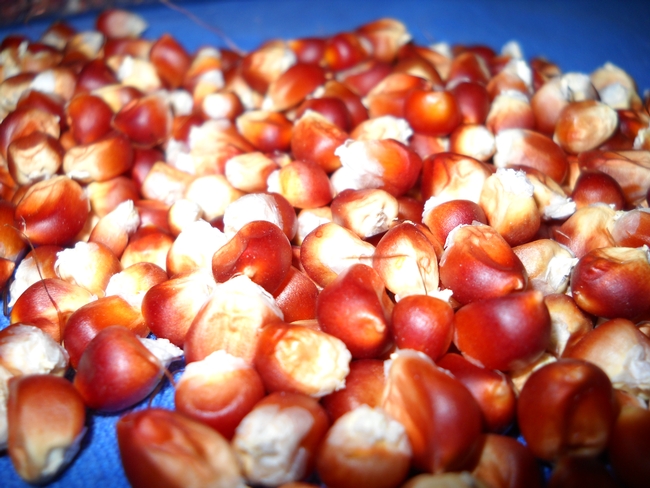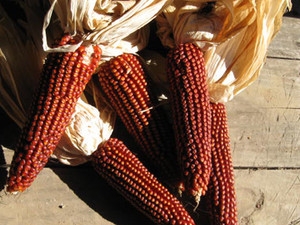A Pretty Corny Story
Ahhhh...summer! Homegrown tomatoes, juicy watermelon and fresh corn on the cob. At least that's what comes to mind, especially in these chilly, late winter days. Many of you know the joy of backyard gardening that includes picking ripe ears of sweet corn, shucking them right there and popping them into boiling water. Along with sliced tomatoes, fresh basil and green beans from the garden, that is what I call “Summer Dinner.” Lucky as I am to have a sizeable backyard garden, I have always grown a good harvest of delicious sweet corn to enjoy in those dog days of August. Last year, however, I had a new adventure with field corn.
Last summer, my interest turned to growing corn that could be dried and ground into cornmeal or polenta, made into masa for tortillas or tamales, or even popped! A friend mentioned specialty grains and flours made by Anson Mills, and passed me a book that featured the story of how this business grew (The Third Plate by Dan Barber ). In his search for the heritage grains of his childhood, Glenn Roberts, founder of Anson Mills, re-discovered Floriani Red Flint Corn and sang its praises. So much so, that, being a good foodie, I had to order the polenta that Anson Mills makes from this corn. Of course, it was more than delicious – so much better that what can be purchased locally. And, though I enjoy cooked polenta, I adore it baked into sourdough rye bread. The Anson Mills Polenta didn't disappoint in that department, either. I decided then, and there, that I would try my hand at growing this special corn. After all, I have always maintained that gardening is just a big science experiment.
Not wanting to use my precious sweet corn space, I decided to procure a plot at the community garden. This was a great choice for a number of reasons. For one, there would be no danger of cross pollination with sweet corn, since very little is grown there. Also, there is plenty of sun there, no difficult shady spaces. Finally, it was really fun to visit the garden regularly and see what everyone else was growing and how it was doing.
I had to look around a bit to order my seeds. It seems there are not many sources for this increasingly popular variety. I finally found some at Southern Exposure Seed Exchange. I had never looked at their website before to order seeds as they are in Virginia. However, they have an impressive array of organic and heirloom vegetable, herb, and flower seeds, dedicated to “saving the past for the future.” They have several pages featuring dent, flint and flour corn. I never realized there was a difference! My Floriani Red Flint would take 100 days to grow 10 feet tall or more. The online catalog described it as a beautiful medium to deep red kernal that is slightly pointed, provides cornmeal with a pink cast, and makes polenta with a remarkably rich and complex flavor. Just what I was looking for!
After a bit of research on planting practices and care, I prepared my plot and was able to put seeds in the ground around mid-June. I planted the same way I usually do for sweet corn. Lots of amendment as corn is a heavy feeder, rows three feet apart, two seeds in a hole to fool the birds. I planted in furrows and hilled up to prevent lodging (blowing down) and provide mini-canals for irrigation. When the plants emerged, I thinned to about 12 inches. I watered almost daily at first, then every other day, and withheld water for the weeks of drying on the stalk. I also added bloodmeal when the corn was 6 inches high and 12 inches high. The amazing part was how tall the plants grew, some were probably more that 10 feet! The tricky part was deciding when to harvest. With field corn, it is necessary to allow the ears to mature and dry on the stalk. I checked weekly when it looked like the corn was nearing readiness, and finally harvested the ears in early October. I shucked the ears and let them dry a bit more in net bags in my garage. Finally, one sunny day in November, I sat on the patio and laboriously removed the kernals from the ears (that's another story).

As for my next project (you knew this was coming), I put in a cover crop of red clover, both in my backyard garden and in my community plot. The plan is to plant hard red spring wheat. I have the seeds and am reading up on harvesting, threshing and winnowing. Perfect for these long winter nights.
Resources
Floriani Red Flint Corn: The Perfect Staple Crop - Real Food ...
Floriani Red Flint Flint Corn 42 g : Southern Exposure Seed Exchange ...
How to Grow Floriani Red Flint | Home Guides | SF Gate
Learn How to Make Hominy Corn - Real Food - MOTHER EARTH NEW
About Corn | Anson Mills - Artisan Mill Goods from Organic Heirloom ...
Corn Tortillas Recipe : Alton Brown : Food Network
The Easy Way to Make Fresh Corn Tortillas at Home | Serious Eat
